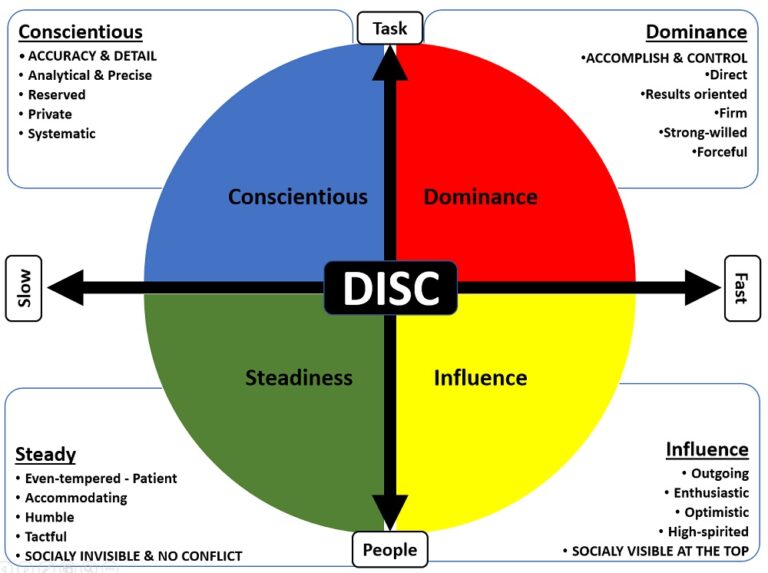USING THE FOUR PERSONALITY STYLES TO IMPROVE YOUR SELLING SKILLS
Which Style makes the best Salesperson?
If you are looking for a quick way to improve your selling approach with customers, take a look at the DISC Assessment. Most of us have gone through a personality assessment of some kind in our life. There’s Myers Briggs, Gallup Strength Finders and hundreds more. They are all good in their own way. However, DISC has its particular advantages for salespeople.
First, it’s extremely accurate as most of the assessments are. If they weren’t, personnel departments would not allow their use in a professional work environment. Still not convinced? Take one and see. It’s amazing how simple questions can help determine your personal style. Is it perfect and correct 100% of the time? Only as much as you answer the questions consistently.
Second, it’s quick and inexpensive. The actual assessment takes 15-20 minutes. If you have the time and resources available, I think they all have their advantages. So, take them all. However, if you want a quick read on yourself, your sales team, and your customers, DISC is a great place to start. The inexpensive part makes it possible for larger teams to participate.
Third, DISC is easy to understand and remember. This makes it possible to actually implement it in your daily life. Myers Brigs has 16 different personality combinations. Strength Finders has 34 themes. That’s too many combinations to even think about let alone remembering while in front of a customer. DISC only has four quadrants which people fall into in varying intensity levels. This is much easier to remember when involved in a busy selling environment.
Fourth and most important is that we can apply DISC to our customers. This is what makes it such a valuable sales tool. The other assessments are great for a deeper understanding of ourselves. But only great if you can get your customer to take those assessment and tell you their results. That’s not likely going to happen. With an understanding of DISC, we can observe our customer’s work space, their communication, and behaviors to determine which quadrant they might be in. The word choices a customer makes are often clear indicators of their DISC profile.
For all those reasons, I added the product to my sales workshops with a lot of positive results. It’s a new way to look at communication. A short training session and a one-page sheet help salespeople understand how to better connect with their customers. This method also allows them to use it in their daily selling life. The pace of life as a salesperson is very busy. We need a quick reminder of how to structure our sales calls to be more effective.
How do I use DISC in Sales?
First step is to understand your own style. How do you show up to your customers? Are you a data cruncher, a social bug, a quiet observer, or a leading force? The next step is for you to understand that customers don’t want you to treat them as you want to be treated. If you are a data cruncher, Great! Your customer doesn’t care. They only care about your spectacular data if they too are a data cruncher. If not, you can easily alienate them with your multi-colored Excel spreadsheets and pivot tables.
The next step is figuring out your customer’s DISC profile. To do that takes some practice. While your accuracy gets better over time, it’s never perfect. One reason is that some people have very dominant DISC profiles and some are closer to the middle. When someone is very strong in one profile, it’s easier to identify and sell to their style.
The final step is to modify your sales approach based on your customer’s DISC style. When we discuss this in workshops, I’m often asked if this is being fake or insincere. “I want to be honest and open with my customers so they know the real me.” That’s great, but not relevant to how your customer wants to be sold to. You are not changing the information, nor preventing yourself from being genuine. You are simply putting the information together and communicating it in the best way for the customer to understand it.
Calling on a long-term customer once, I knew he was being heavily prospected by my competition. Thinking that I needed to step up my game, I went all out on data and information. Never in the 12 years prior had I done anything like this with him. I had charts, graphs and even pictures. I wanted him to know that I wasn’t taking his business for granted and that there was real science behind why my products were better. After a few minutes, he pushed all my papers back across the table and said, “That’s why I buy from you. I don’t want to know all that, but I sure hope you do”. When stressed, I had resorted to my quadrant of the world and forgot to think about my customer’s DISC style. We moved on at lunch that day and never again spoke about digestible amino acids and the process which poultry use to transfer nutrients across the gut wall. I mean who wouldn’t want to see pictures and graphs of that at a lunch meeting?
One question I am often asked: “Which style is best for sales?” I’ll answer that in the podcast episode.
_______________________________________________________________________________________


